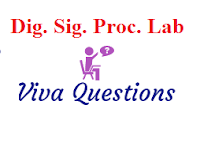
Home/ lab viva questions/ DSP Part-II& III
1. Define one-sided and two-sided Z-transform.

2. What is region of convergence (ROC)?
The region of Z magnitude (|Z|) for which x(n).|Z|-n is absolutely summable
3. State the Initial value and final value theorem with regard to
Z-transform.

4. Define Z-transform of unit step signal.
Z/(Z-1) ROC |z|>1
Z/(Z-1) ROC |z|>1
5. What are the different methods available for
inverse Zs-transform?
Residue method, Partial fractions method, Long division method, Convolution integral method
Residue method, Partial fractions method, Long division method, Convolution integral method
6. When the z-domain transfer function of the system
can be directly obtained from s-domain transfer function?
When input is an Impulse sampled signal.
When input is an Impulse sampled signal.
7. Define the transfer function of an LTI system.
For Discrete time systems: Z transform of impulse response of system
For Continuous time systems: Laplace transform of impulse response
For Discrete time systems: Z transform of impulse response of system
For Continuous time systems: Laplace transform of impulse response
9. Give the importance of convolution and
deconvolution operations using Z-transform.
10. Give the conditions for stability of an LTI
discrete time system in z-plane.
The ROC should contain unit circle with in it.
11. Explain when an LTI dicrete time system will be causal.
11. Explain when an LTI dicrete time system will be causal.
The ROC should contain infinite. i.e system impulse response is a right sided signal.
12. State the convolution property of
Z-transform.
------------->
------------->
13. state the properties of Z transform?
click here
14. Z-transform of various signals?
click here

 15. What are the phase factors involved in all stages of computation in 8-point DIF radix-2 FFT?
15. What are the phase factors involved in all stages of computation in 8-point DIF radix-2 FFT?
------------->
------------->
13. state the properties of Z transform?
click here
14. Z-transform of various signals?
click here
Part-III: DFT & FFT
1. Define DFT of a discrete time sequence?

2. Define inverse DFT.


3. What is the relation between DTFT and DFT?
4. What is the drawback in Fourier transform and how is it overcome?
4. What is the drawback in Fourier transform and how is it overcome?
Fourier transform is that it is not truly realizable in practice but we can get closer, it is not applicable to all signals, so we go for Laplace in continuous , Z in discrete.
5. List any four properties of DFT .
linearity Property : ax1(n)+bx2(n)→aX1(ω)+bX2(ω)
Duality Property: X(N)⟷Nx[((−k))N]
Complex conjugate property: x∗(n)⟷X∗((K))N=X∗(N−K)
Circular shift property: x(n)exp(j2ΠKn/N)⟷X((K−L)
5. List any four properties of DFT .
linearity Property : ax1(n)+bx2(n)→aX1(ω)+bX2(ω)
Duality Property: X(N)⟷Nx[((−k))N]
Complex conjugate property: x∗(n)⟷X∗((K))N=X∗(N−K)
Circular shift property: x(n)exp(j2ΠKn/N)⟷X((K−L)
6. What is FFT, What it's importance?
FFT stands for Fast Fourier Transform, this is same as DFT but algorithm is different by FFT with in lees time we can compute Fourier transform compared to DFT.
7. compare FFT and DFT?
7. compare FFT and DFT?
DFT and FFT both are used to represent a discrete time signal in frequency domain, But DFT procedure is formula based where FFT is algorithm based, FFT is more efficient and faster than DFT, i.e if a sequence contains N samples then to calculate
DFT no. of multiplications and additions required are: N2 , N(N-1)
FFT no. of multiplications and additions required are : (N/2) log2(N), N log2(N)
DFT no. of multiplications and additions required are: N2 , N(N-1)
FFT no. of multiplications and additions required are : (N/2) log2(N), N log2(N)
Decimation In Time (DIT), Decimation In frequency (DIF)
9. Draw the DIT FFT structure with the length of 8?
 10. Draw the DIF FFT structure with the length of 8?
10. Draw the DIF FFT structure with the length of 8?
9. Draw the DIT FFT structure with the length of 8?

11. What is phase factor or twiddle factor?
It is defined as WN = e-j2π/N
It is defined as WN = e-j2π/N
12. What are the phase factors involved in all stages of computation in the 8-point DIT radix-2 FFT?
 14. Draw the basic butterfly diagram or flow graph of DIF radix-2 FFT?
14. Draw the basic butterfly diagram or flow graph of DIF radix-2 FFT?
First stage: W80
Second stage: W80, W82
Third stage: W80, W81, W82, W83
13. Draw the basic butterfly diagram or flow graph of DIT radix-2 FFT?

First stage: W80
Second stage: W80, W82
Third stage: W80
16. What is magnitude and phase spectrum?
Magnitude spectrum is the graph between Fourier transform magnitudes and frequency. Phase spectrum is the graph between Fourier transform phases and frequency.
Magnitude spectrum is the graph between Fourier transform magnitudes and frequency. Phase spectrum is the graph between Fourier transform phases and frequency.
Related Tags: Digital signal processing (DSP) lab basic viva question, Signal processing lab viva questions with answers, dsp lab viva questions with answers pdf digital signal processing, interview questions and answers digital signal processing oral questions and answers pdf, matlab lab viva questions with answers, viva questions for ds lab with answers, digital signal processing objective type questions answers pdf, viva questions for dsp lab with answers, dsp questions and answers pdf


![x_{1}[n]*x_{2}[n]](https://wikimedia.org/api/rest_v1/media/math/render/svg/c729fc738effd3f2e021a0aafd5b601e5636866e) ------------->
-------------> 
![x_{1}[n]x_{2}[n]](https://wikimedia.org/api/rest_v1/media/math/render/svg/ef6743e17b24b69f8e3967724f056c04b779ee3e) ------------->
-------------> 















DSP Full Formamazing
ReplyDeleteOrganic chemistry tutor
ReplyDeleteOrganic chemistry
Thanks For Your Blogs
ReplyDeletecloud hr software
best payroll software singapore
information security
ReplyDeleteCloud Services
Cloud Computing Services